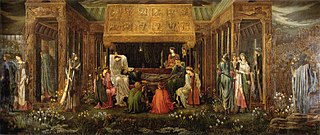Galatea is an ancient Greek name meaning "she who is milk-white".
Pygmalion or Pigmalion may refer to:

Sir Edward Coley Burne-Jones, 1st Baronet, was an English painter and designer associated with the Pre-Raphaelite Brotherhood's style and subject matter.
Salome was the daughter of Herodias, and nemesis of John the Baptist.

The Adoration of the Magi or Adoration of the Kings or Visitation of the Wise Men is the name traditionally given to the subject in the Nativity of Jesus in art in which the three Magi, represented as kings, especially in the West, having found Jesus by following a star, lay before him gifts of gold, frankincense, and myrrh, and worship him. It is related in the Bible by Matthew 2:11: "On entering the house, they saw the child with Mary his mother; and they knelt down and paid him homage. Then, opening their treasure chests, they offered him gifts of gold, frankincense, and myrrh. And having been warned in a dream not to return to Herod, they left for their own country by another path".
Love Among the Ruins may refer to:
Hope is an attitude which combines desire with expectation.
The Wheel of Fortune or Rota Fortunae has been a concept and metaphor since ancient times referring to the capricious nature of Fate. Wheel of Fortune may also refer to:

The Mystical Nativity is a painting in oil on canvas dated c. 1500–1501 by the Italian Renaissance master Sandro Botticelli, in the National Gallery in London. It is his only signed work and has an unusual iconography for a painting of the Nativity.
Nativity or The Nativity may refer to:

The Nativity of Jesus has been a major subject of Christian art since the 4th century.

The Last Sleep of Arthur in Avalon is a painting by Edward Burne-Jones, started in 1881. The massive painting measures 279 cm × 650 cm, and is widely considered to be Burne-Jones's magnum opus.
The Star of Bethlehem is a Christian tradition regarding the birth of Jesus.

Pygmalion and the Image is the second series of four oil paintings in the Pygmalion and Galatea series by the Pre-Raphaelite artist Edward Burne-Jones which was completed between 1875 and 1878. The two collections may be seen below, in the Gallery, the first being now owned by Lord Lloyd Webber, and the second housed at the Birmingham Museum & Art Gallery. This article deals with an appraisal of the second series.

The Flower Book by Edward Burne-Jones (1833–1898) is a series of 38 round watercolours, each about six inches across, painted from 1882 to 1898. The paintings do not depict flowers; rather, they were inspired by the flowers' names. Burne-Jones called them "a series of illustrations to the Names of Flowers". "Not a single flower itself appears", according to his wife Georgiana. They were painted for his private pleasure, many while he was resting at his summer home in Rottingdean, and were described by his wife as the "most soothing piece of work that he ever did". In 1905 Georgiana, by then a widow, published a limited edition of high-quality colour facsimiles.

The Nativity is one of a pair of monumental paintings by the Pre-Raphaelite artist Edward Burne-Jones commissioned for the chancel of the church of St John the Apostle, Torquay, England, in 1887. The Gothic Revival church was designed by architect George Edmund Street in the 1860s and decorated by Morris & Co., the decorative arts firm in which Burne-Jones was a partner.
Pygmalion and Galatea are two characters from Greco-Roman mythology.
This page is based on this
Wikipedia article Text is available under the
CC BY-SA 4.0 license; additional terms may apply.
Images, videos and audio are available under their respective licenses.







